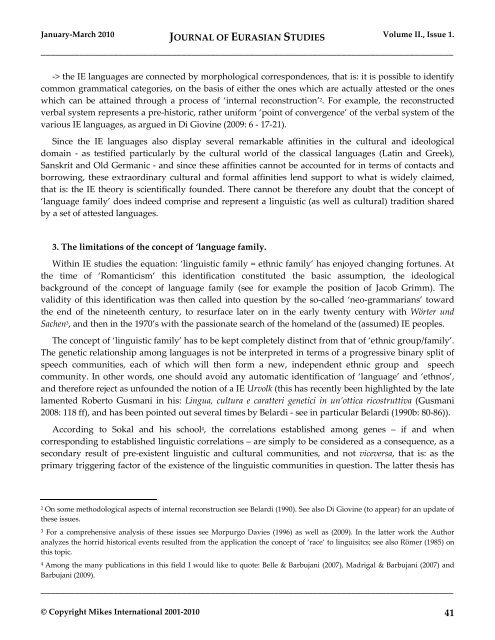EurasianStudies_0110..
EurasianStudies_0110..
EurasianStudies_0110..
You also want an ePaper? Increase the reach of your titles
YUMPU automatically turns print PDFs into web optimized ePapers that Google loves.
January-March 2010 JOURNAL OF EURASIAN STUDIES Volume II., Issue 1.<br />
_____________________________________________________________________________________<br />
-> the IE languages are connected by morphological correspondences, that is: it is possible to identify<br />
common grammatical categories, on the basis of either the ones which are actually attested or the ones<br />
which can be attained through a process of ‘internal reconstruction’ 2. For example, the reconstructed<br />
verbal system represents a pre-historic, rather uniform ‘point of convergence’ of the verbal system of the<br />
various IE languages, as argued in Di Giovine (2009: 6 - 17-21).<br />
Since the IE languages also display several remarkable affinities in the cultural and ideological<br />
domain - as testified particularly by the cultural world of the classical languages (Latin and Greek),<br />
Sanskrit and Old Germanic - and since these affinities cannot be accounted for in terms of contacts and<br />
borrowing, these extraordinary cultural and formal affinities lend support to what is widely claimed,<br />
that is: the IE theory is scientifically founded. There cannot be therefore any doubt that the concept of<br />
‘language family’ does indeed comprise and represent a linguistic (as well as cultural) tradition shared<br />
by a set of attested languages.<br />
3. The limitations of the concept of ‘language family.<br />
Within IE studies the equation: ‘linguistic family = ethnic family’ has enjoyed changing fortunes. At<br />
the time of ‘Romanticism’ this identification constituted the basic assumption, the ideological<br />
background of the concept of language family (see for example the position of Jacob Grimm). The<br />
validity of this identification was then called into question by the so-called ‘neo-grammarians’ toward<br />
the end of the nineteenth century, to resurface later on in the early twenty century with Wörter und<br />
Sachen 3, and then in the 1970’s with the passionate search of the homeland of the (assumed) IE peoples.<br />
The concept of ‘linguistic family’ has to be kept completely distinct from that of ‘ethnic group/family’.<br />
The genetic relationship among languages is not be interpreted in terms of a progressive binary split of<br />
speech communities, each of which will then form a new, independent ethnic group and speech<br />
community. In other words, one should avoid any automatic identification of ‘language’ and ‘ethnos’,<br />
and therefore reject as unfounded the notion of a IE Urvolk (this has recently been highlighted by the late<br />
lamented Roberto Gusmani in his: Lingua, cultura e caratteri genetici in un’ottica ricostruttiva (Gusmani<br />
2008: 118 ff), and has been pointed out several times by Belardi - see in particular Belardi (1990b: 80-86)).<br />
According to Sokal and his school 4, the correlations established among genes – if and when<br />
corresponding to established linguistic correlations – are simply to be considered as a consequence, as a<br />
secondary result of pre-existent linguistic and cultural communities, and not viceversa, that is: as the<br />
primary triggering factor of the existence of the linguistic communities in question. The latter thesis has<br />
2 On some methodological aspects of internal reconstruction see Belardi (1990). See also Di Giovine (to appear) for an update of<br />
these issues.<br />
3 For a comprehensive analysis of these issues see Morpurgo Davies (1996) as well as (2009). In the latter work the Author<br />
analyzes the horrid historical events resulted from the application the concept of ‘race’ to linguisitcs; see also Römer (1985) on<br />
this topic.<br />
4 Among the many publications in this field I would like to quote: Belle & Barbujani (2007), Madrigal & Barbujani (2007) and<br />
Barbujani (2009).<br />
_____________________________________________________________________________________<br />
© Copyright Mikes International 2001-2010 41

















